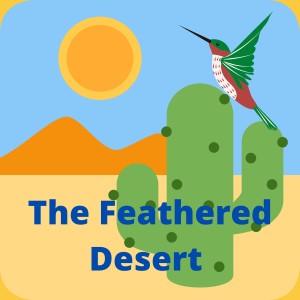
10.4K
Downloads
144
Episodes
Backyard bird feeding is one of the most enjoyable and rewarding hobbies on earth. Join Cheryl and Kiersten as they talk all about bird feeding in the desert Southwest area of the United States. They talk birds, seed, feeders, and dealing with those pesky unwanted visitors!
Episodes

Monday Mar 20, 2023
The Sonoran Gold Star Hotel: Saguaro Cactus
Monday Mar 20, 2023
Monday Mar 20, 2023
Summary: Have you ever stopped to really look at a Saguaro cactus? Do you know how many birds use this great plant as a hotel, water source, and food source? Join Cheryl and Kiersten to find out!
For our hearing impaired listeners, a transcript of this podcast follows the show notes on Podbean.
Show Notes:
https://www.nps.gov/sagu/index.htm
https://www.npa.gov/sagu/learn/nature/birds.htm
The Arizona Republic Sunday, March 12, 2023
"Why saguaro is so important to Arizona" by Sarah Lapidus
The Arizona Republic, Sunday, June 21, 2020
"So Long, Saguaro?" by Debra Utacia Krol
Background bird song: Naturescapes Backyard Birds www.naturescapes.com
Our email address, please reach out with comments, questions, or suggestions:
Transcript
Host Voice: Welcome to the Feathered Desert a podcast all about desert bird feeding in the Southwest region of the United States. (bird calls and songs play)
Cheryl: Intro
We have all seen these iconic cacti as we travel through the Phoenix Valley. Maybe you done think twice about it, but you should because this huge tree-like cactus is a vital part of the desert we live in.
Kiersten: Saguaros have ecological importance to all species that live near them including us. The saguaro is important to the survival of desert species: everything from Big Horn sheep to native bees; from coyotes to the countless birds that depend on it.
Now, most of us are aware that the Gila Woodpecker and the Gilded Flicker excavate their nests in the saguaro cactus. What you may not be aware of is that these birds do not harm the cactus. Since these birds make a new hole/nest each year. Last year’s excavated hole is prime real estate to a long list of desert birds such as: Elf owls, Ferruginous Pygmy owl, Purple Martins, Brown-crested, and Ash-throated flycatchers.
Now, Harris hawks, Great horned owls, Red-tail hawks, and White-winged doves build nests among the arms of these tall cacti.
Cheryl: Saguaro cactus provides a buffet during the toughest part of the year in our desert-summer.
The saguaro is a keystone species that provides food many desert animals, Saguaros have hundreds of flowers that bloom several per day from late April to early June. The flowers open at night and close the following afternoon. Saguaros synchronize their blooming so the giant cacti are not blooming all at the same time.
Lesser Long nosed bats visit the flowers at night. Birds like the white-winged dove and the Gila Woodpecker visit the flowers the following morning.
Kiersten: that’s not all for this buffet table…
The fruit of the saguaro cactus is mature in June and early July. The rind splits open into 3-4 sections that peel back to expose the juicy red pulp embedded with up to 2,000 tiny seeds. 1 out of a million seeds will become a cactus with arms. The fruit ripen during the peak of drought in early summer and are about the only moist food source for many birds, mammals, and insects during this part of the year.
Cheryl: How the saguaro helps us-humans
Saguaros and other cacti photosynthesis at night to reduce water loss. This large cactus takes in carbon dioxide and holds in for its whole life. When you see an expired cactus-saguaro and it looks ashy- that’s because of the stored carbon dioxide it pulled out of the air so that people can breathe cleaner air.
Kiersten: Challenges facing this giant.
Climate change-Saguaros ae not freeze tolerant, nor do they handle high night time temperatures very well. Because they take so long to grow, a lot of younger saguaros don’t make it. Wildfires, invasive plants that suck up water, drought, extreme temps, and a reduction in nurse plants. Saguaros seedlings require species such as mesquite, palo verde, and ironwood trees to make it through those first critical decades. Nurse trees create a microenvironment that is more conducive for the seedlings to survive. But fewer and fewer of these woody plants are on the landscape for the saguaro to grow under due to cattle ranching and woodcutting.
Cheryl: Closing
This amazing plant does it part to better the desert community it thrives in. So many birds check into its massive high rise to setup house to raise their babies. Because, of its importance to our desert the Saguaro is protected by Arizona law. Next time you are driving across town take a second look at this beautiful, stately cactus. It deserves it.

No comments yet. Be the first to say something!